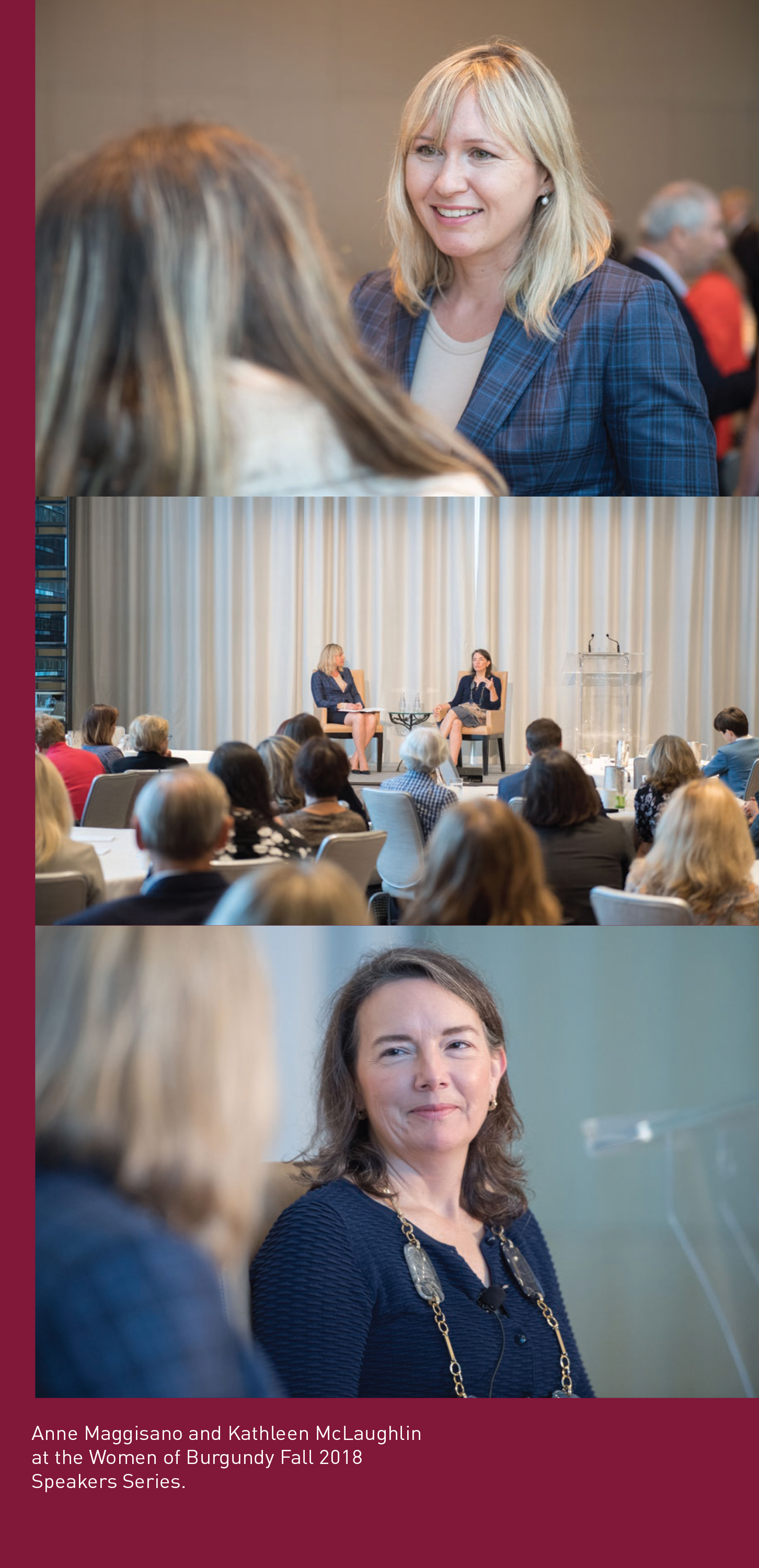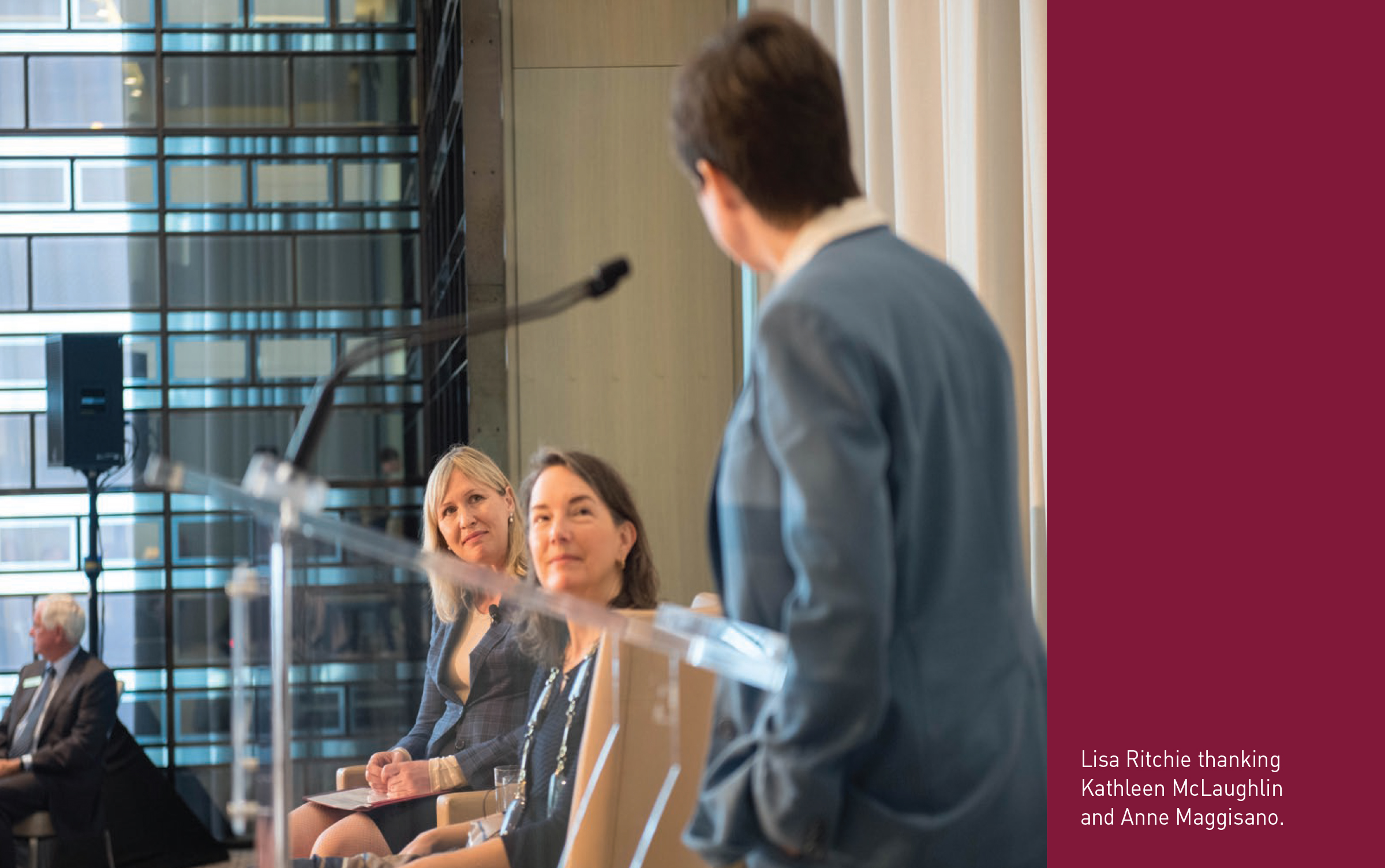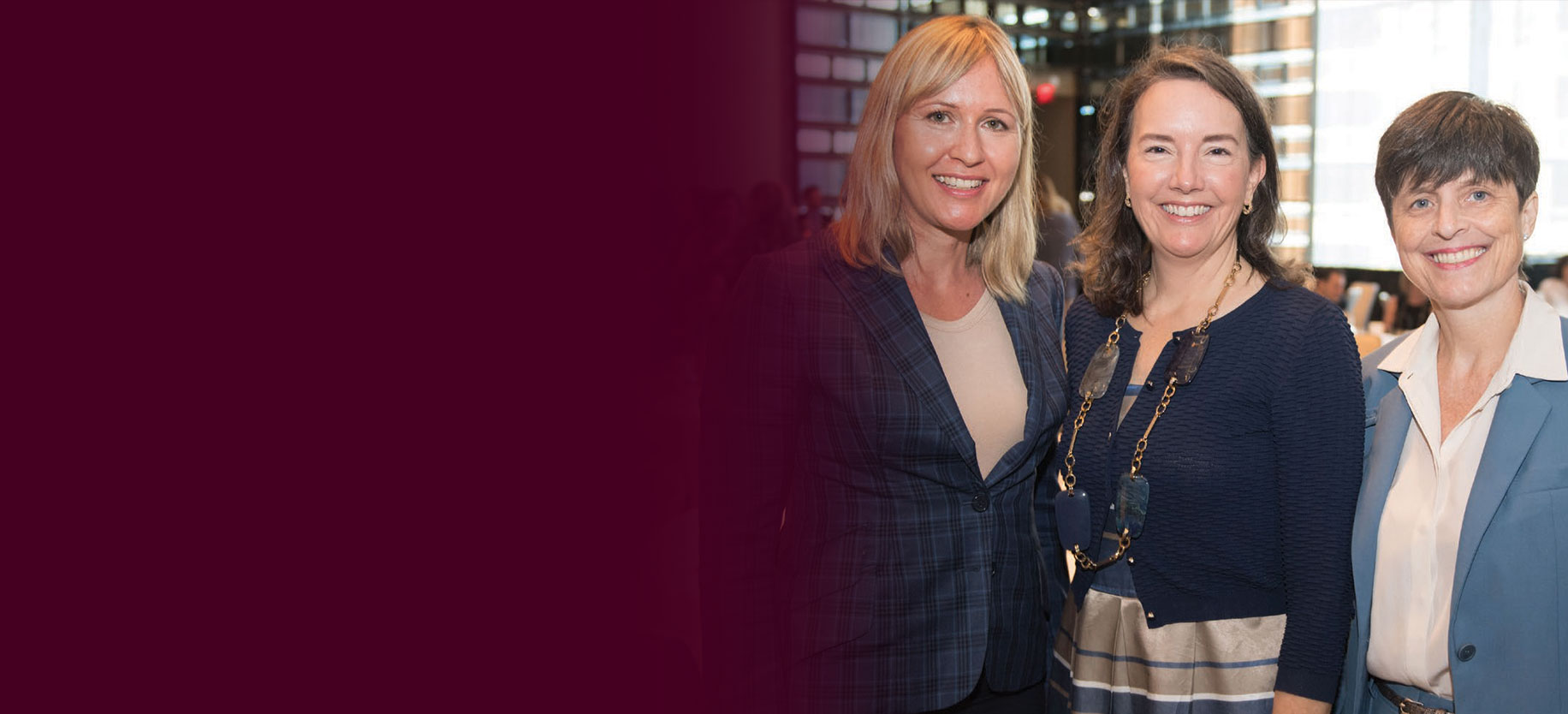In September of 2018, the Women of Burgundy hosted a fascinating and far-reaching conversation between Walmart’s Chief Sustainability Officer and Foundation President, Kathleen McLaughlin and Anne Maggisano, Burgundy Vice President of Client Relations. The most memorable moments of that discussion about sustainability, mobilizing change in corporate and consumer behaviour, and maximizing shareholder value are captured here.
Anne Maggisano: How has Walmart’s sustainability strategy evolved since you first started there in 2013?
Kathleen McLaughlin: People are often surprised to hear that Walmart set out its aspirational public goals for sustainability as early as 2005: to be powered 100% by renewable energy, to generate zero waste in operations and to have more sustainable products. We set these goals right after Hurricane Katrina; the Walmart leadership team was right in the middle of dealing with that disaster. Coincidentally, the leadership had also spent the previous year with folks from the Environmental Defense Fund and Conservation International, to discuss what we were doing about the environment and social issues.
In the fall of 2005, CEO Lee Scott made a speech about sustainability that unleashed this huge wave of energy and execution towards those goals in the company. Once we knew the direction in which we were moving, everyone immediately took off running.
AM: How would you characterize your role in driving Walmart’s sustainability agenda? Did you accelerate or change the direction in which the company was moving?
KM: By the time I joined the company, there was already a substantial effort being made to deal with energy and waste, as well as other issues. Globally today, Walmart is powered one-third by renewable energy. We’re on target to get to 50% by 2025, and we’ll keep going. On waste, in the U.S. for example, we’ve diverted just north of 80% of waste from our operations.
I’d say the biggest change in the last five years is taking a more systemic, integrated approach to the issues—whether it’s climate, waste, social issues—and building the business case around action, then working with many others in those chains to transform them. It’s the same kind of problem-solving approach you would bring to any business venture: innovation, technology, changing processes, changing practices, shifting behaviour, shifting mindsets, and shifting the way the economics work. That systemic problem solving has helped accelerate social and environmental outcomes.
AM: You’ve argued that sustainability is not just the right thing to do for society, but it will also increase the value of Walmart as a business, which will eventually translate into increased value for shareholders. Can you expand on that?
KM: We are talking about fundamental transformation. This isn’t just about changing some LED lightbulbs and lowering your energy costs. Yes, you do get cost savings, but there are also opportunities for new revenue streams. When we recycle our cardboard and plastics in the store, we are making money by reselling that rather than paying money to send this waste to a landfill.
We are also fundamentally changing the economics by shifting away from a take, make, dispose linear economy that takes all these resources out of the planet, uses them up and then throws them in the dump. That’s not economically viable or sustainable. That material can be repurposed and reused to be more value-creating. We must go from being a linear economy to creating a circular economy, and that requires a massive, system-wide change in behaviour.
We must transform the way our economy works—specifically, the way production and consumption work. Otherwise, there’s no ability to sustain market growth. That means integrating environmental solutions, social solutions and economic solutions.
AM: How does Walmart think about allocating capital to long-term sustainability projects that might reduce profitability in the short term?
KM: There are always trade-offs. When it comes to energy efficiency and renewable energy, for instance, we have LED lightbulbs, HVAC equipment and our proposed project portfolio includes a list as long as my arm, but we can only get funding for a portion of it in any given year. I have to compete for that capital alongside lingerie fixtures and the remodeling of the store and we’re all on the same footing. It comes back to finding solutions that are economic and luckily, so much of what we propose has a very high return on investment and makes a compelling business case.
AM: What is Walmart doing to address climate change?
KM: We’ve managed to reduce our carbon intensity globally by a third since 2005, while at the same time growing the company. We are decoupling emissions from growth.
We spent 10 years doubling our fleet efficiency in the U.S., and that was hard. We worked with Peterbilt and Cummins on more efficient engine design. We used driver behaviour instrumentation feedback to make drivers aware of how fast they were driving and how this affected fuel efficiency. We redesigned the back of the truck and changed how we load packages, as well as how much the trucks could carry. We also reduced the load weight by reducing the amount of packaging. All these initiatives together got us to our goal and enabled us to double fleet efficiency.
If you want to ship a crate of food, there’s no better way to do it than on a Walmart truck. But it’s still fossil fuel dependent. What we want to do is move to alternative fuel, and we’re looking at electric powered heavy-duty vehicles, hydrogen fuel cells and other options. Walmart Canada’s commitment is to get to 100% alternative fuel by 2028. That should give us enough time to do the piloting, the testing, the scaling up, and building the capability to move the whole system in that direction.
We are starting with Tesla. We have 40 electric trucks that we have ordered here in Canada. As we learn, we’ll work with others and continue to evolve until we hit our goal.
A demand signal coming from Walmart and other major retailers is important. If we’re all asking for this and making a long-term commitment, others will be doing this and the transformation will happen more quickly.

AM: You advance the idea that sustainability is important within the operations of Walmart, but also all along the value chain. Who you do business with really matters, and Walmart has a responsibility to elevate sustainability practices all around the world. How does that work in practice?
KM: If I just take emissions, for example, more than 95% of the impact is in the supply chain. When we’re selling Unilever shampoo, we ask Unilever to tell us more about what they do to make its shampoo products, and the amount of plastic they used for example.
One of the things we do for every single category is a lifecycle analysis. We work with a group called The Sustainability Consortium, which reports on the impact of consumption on forests and water and other natural resources. Many retailers and suppliers belong to this consortium. They have a thing called the Sustainability Index, which boils the lifecycle analysis down to the 12 “hotspots” that are most important for every single product category: shrimp, tuna, chicken, cloth-based textiles, synthetic textiles, electronics—every category. And those hotspots—both environmental and social—include things like climate, water quality, labour issues … the whole gamut.
There is a survey connected to every one of those hotspots that goes out to our suppliers and asks about their outcomes and practices. The Sustainability Consortium aggregates that data and shares it with us, so we know who is leading, who is lagging.
AM: Using the lifecycle analysis and survey results, what have you discovered about the seafood value chain?
KM: While Walmart has made significant progress in regard to environmental sustainability in this supply chain, significant challenges still exist. With shrimp, for instance, the main issue is forced labour. Way back in the chain, there are people who go out in vessels in Southeast Asia to catch trash fish that get cut up and fed to the shrimp in the fisheries as they are growing, that then get sold to a wholesaler, that then are sold to a trader, that then are sold to a supplier, and that ultimately are sold to the retailers. The supply chain is very fragmented: we are talking about millions of little fishing boats and people way back in the value chain. So, if you’re Walmart or Loblaw or Sobeys, what do you do about that? What we’ve done is to start by understanding the prevalence and the incidents of those labour practices, then look at the root causes and how to deal with them.
Through the Walmart Foundation, we funded a prevalence study and international justice mission to document and address labour issues in the region. We’ve found that many people from Southeast Asia seeking employment on fishing vessels in Bangkok or Burma, for instance, have to pay exorbitant fees to obtain a passport and in some cases it is not clear where the money goes. They borrow and somehow scrape the money together, and then they’re $2,000 or more in debt. To make things worse, often their passport is withheld and they’re out at sea for six months.
This study helped the industry understand that the recruitment models are at the root of the problem. Walmart’s response was to join an industry consortium called the Leadership Group for Responsible Recruitment. Many retailers, suppliers and social justice groups are working together and providing some additional grants to understand where that money is going. That’s the kind of work that’s happening and the role we’re playing in terms of convening: being at the table, bringing people together, shining a light on a problem, and encouraging others to join us.
The Walmart Foundation funded the Sustainable Fisheries Partnership to introduce vessel monitoring systems that use technology to gather information about conditions at different points in the chain. And then worker tools: hotlines, confidential tip lines and apps. The Foundation also helped fund an app in the Burmese language called Golden Dreams, which is like Yelp for getting a job. Job seekers use it to exchange information about job opportunities. We’re taking a different approach from the conventional: I’m a retailer, you’re my supplier, you’ll sell me shrimp and I’ll write you a cheque. A very different approach. One of the things I spend a lot of time doing is convincing other retailers to join us in this work.
AM: Part of your mandate is to focus on economic opportunity as it relates to the advancement of women.
KM: It is a big priority. About 30% of our senior executives globally are women, which is slightly above the S&P 500 average. Obviously, we want to get to 50%. It’s something we continue to work on.
The first way we approach this is through our own talent pipeline and then by supporting the development of diverse talent outside of Walmart through our philanthropy. Within Walmart, we have a broad program of interventions to shift our whole system and make it more inclusive, whether it’s through our recruiting and hiring practices, our development courses, or implicit-bias training. Outside of Walmart, we have made a $100 million philanthropic investment to help accelerate the mobility of front-line workers in retail and related sectors.
The second way that we approach it is through sourcing. If you think of Walmart’s purchase order as a form of development capital and what that can do to unlock opportunities for business owners, for small business, and for diverse-owned business, it’s massive. With respect to women-owned businesses, for example, we set a goal to source $20 billion for women-owned businesses over a five-year period. And we met that. So looking at every single category, we ask what does the supplier base look like? Which categories seem to have more women entrepreneurs? How do we support them? What are the barriers?
One practical barrier is access to capital. A lot of times a woman with a small business will want to expand, but she can’t get the capital because she doesn’t have a purchase order. She doesn’t have a purchase order because retailers may not buy from her without evidence she can provide the scale and volume. So it’s a catch-22. We created something called the Supplier Alliance, where we negotiated an agreement with banks that if someone had a letter of interest from us that would be enough to get the capital to scale up. That really helped. That’s what enabled a woman who was selling tortillas in Atlanta and looking at expansion to become a major national supplier of ours and who now employs 3,000 women.
We’ve also looked to embed our philanthropy into the supply chain and asked, where are the women in different supply chains—farming, retail, retail-type professions in China or in Africa—and what do they need? We set a goal to train one million women factory workers by asking what opportunities for advancement there were for those women and by using philanthropy to invest in their future. A wise investment.

This publication is presented for illustrative and discussion purposes only. It is not intended to provide investment advice and does not consider unique objectives, constraints or financial needs. It is not intended as an offer to invest in any Burgundy investment strategies. Under no circumstances does this publication suggest that you should time the market in any way or make investment decisions based on the content. Select securities may be used as examples to illustrate Burgundy’s investment philosophy. Research used to formulate opinions was obtained from various sources and Burgundy does not guarantee its accuracy. Forward looking statements are based on historical events and trends and may differ from actual results. Any inclusion of third party books, articles, and opinions does not imply Burgundy’s endorsement or affiliation. The information in this publication is as of the date of the publication and will not be revised or updated to reflect new events or circumstances.

